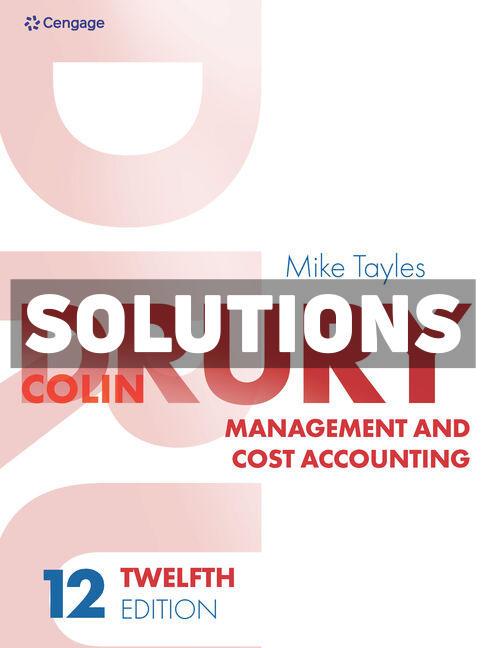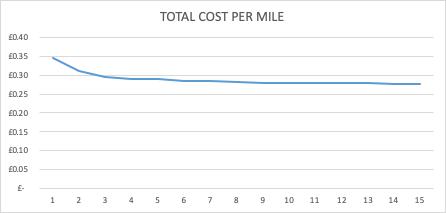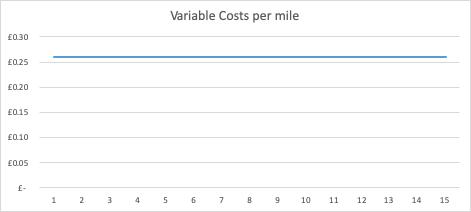

Part I Solutions
An introduction to cost terms and concepts
The relevant costs per satisfactory scan are cheaper on Machine XR50 and therefore brain scans should be undertaken on this machine.
The fixed production overhead rate per unit of output has been calculated because there appears to be only one product produced. Alternatively, a fixed production hourly overhead rate can be calculated and charged to the product on the basis of the number of hours which the product spends in each department.
cSelling and production cost per unit of output = £196,000 9,800 �������������������� = £20
Administration cost per unit of output = £98,000 9,800 �������������������� = £10 (b) Selling price per unit £1,218 × 100 85 =1,433
MindTap: Solutions to Discussion questions
– Chapter 2
1. ANS: Cost object is any activity for which a separate measurement of costs is desired. Examples may vary.
Please review Chapter 2 Cost objects.
2. ANS: Irrelevant costs will not be affected by a decision. Relevant costs will be changed by a decision Examples may vary.
Please review Chapter 2 Relevant and irrelevant costs and revenues.
3. ANS: Product costs are identified with goods purchased or produced for resale and they are attached to products and included in the inventory valuation of goods. Period costs are not included in the inventory valuation of goods and they are treated as expenses for the period in which they are incurred. Examples may vary.
Please review Chapter 2 Period and product costs.
4. ANS: An opportunity cost measures the opportunity that is sacrificed when the choice of one course of action requires that an alternative be given up. Examples may vary.
Please review Chapter 2 Opportunity costs.
CHAPTER 2 – Introduction to Costs and Concepts
To: The Area Manager
From: M.A.
Accountant
Subject: Analysis of costs
Date: 01/01/20X1
Re: Analysis of costs
The report below analyses the different costs based on the mileage per van and highlights the cost behaviour as the mileage changes.
Annual cost of running a delivery van
The cost of running the van would start at £3,869.17 for 10,000 miles increasing to £ 47,475.00 for 150,000 miles. This supports your initial assertion that the total cost per mile will always fall as the delivery van is driven for a greater number of miles. However, can sometimes be affected by incremental costs like the one for tyres and spare parts.
Further analysis shows that the cost decreases as the miles increase. This is shown below.
The total cost per mile

Variable cost per mile

Fixed cost per mile

The cost per mile is 39p for 10,000 miles, 35p per mile for 20,000 miles, 33p for 30,000 to 50,000 miles, reducing to 32p up to 150,000 miles. This shows that it is cheaper to run the van as the mileage increases.
Although the total variable cost increases as the miles increase, you will notice that the variable cost per mile remains the same (or is fixed) at any level. This will likely be the same for any given mileage unless there is a discount for bulk orders.
The total fixed cost would always remain the same with the exception of any stepped fixed costs. However, the fixed cost per mile tends to decrease as the mileage increases. This is due to the fact that the cost is shared (spread) across a greater number of miles.
For a detailed breakdown please refer to the Excel file attached.
Please feel free to get in touch if you have any questions.
Prepared by M.A Accountant
Chapter 1: South African Case Study – Excelsior University
Teaching Note
During the past two decades many organizations including universities have faced dramatic changes in the environment in which they operate. In the context of South Africa, there is increasing competition for ‘quality students’ which is being exacerbated by the arrival of overseas universities in the country, the rapid development of new IT technology and communication systems which has increased the reach of competitors both foreign and local - also price competition has begun to manifest itself for the first time. To compete successfully in today’s environment, universities will have to make student satisfaction an overriding priority and the courses and programmes offered by universities will have to be responsive to the skills required by the marketplace – offering degrees and diplomas which simply educate students without giving them the required skills to compete for positions in a highly competitive job market would seem to be an exercise in futility.
Some of the strategic challenges facing Excelsior University at this juncture can be summarized as follows:
• The schooling system in South Africa is poor, declining and the credibility of the school leaving certificate is questionable – although there is a surfeit of students applying to universities, only a small fraction of them have mathematics as a subject and many of those only have modest passes in this subject. The upshot of all of this is that competition is growing for quality science, commerce and law students for example.
• Given that there are reportedly 600, 000 unemployed graduates in the country almost all of them graduates in the humanities, Excelsior, with 50 per cent of its student body being in humanities, would need to drastically change the composition of its student body since it is producing graduates who are highly likely to simply join the ranks of the unemployed – needless to say this is a waste of scarce resources particularly since the government contributes about 60 per cent of the tuition costs of students in South Africa.
• As Excelsior is one of the most expensive universities in the country and competition for ‘ quality students’ is increasing, very close attention will have to be given to the cost structure of the university so that fees are reduced in the future, or at least so that fee increases are severely curtailed . Two worrying statistics are that the university has the lowest student to staff ratio in the country while the cost of administrative staff at the university is equal to the cost of academic staff raises questions as to whether the university is not overstaffed as regards both academic and administrative staff.
• The advance of the internet together with advanced communication and delivery systems gives universities generally the ability to offer courses on a distance basis –this has forever changed the competitive environment – from Excelsior’s standpoint these changes are even more relevant since it is situated in a rural area and is almost completely dependent on residential students.
• The university should give consideration to semesterizing a number of its courses so that new students are able to commence their studies either at the beginning of the year or mid-year – this might attract a few more ‘quality students’ and given that each additional student recruited gives rise to an additional contribution of about R76,000 (the university has a contribution ratio of about 97 per cent) every additional student recruited is financially very important to the university. The university does not offer bursaries and it has unutilized facilities so it seems logical that it should offer bursaries to high achieving students to induce them to attend the university since the marginal cost of one additional student is only R1,500 and the government contributes about R48,000 per annum to the cost of educating a student.
The problem with universities is that for a very long time they have been insulated from competition and have been operating in a cocoon with no real incentive to change their modus operandi – universities have been led largely by academics with limited financial skills and little or no management training. Given rapid changes in the environment and the fact that the budgets of some large universities run into several billion Rands the governing bodies of universities might have to re-think what sort of person they want to lead their universities into the future.
